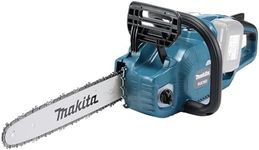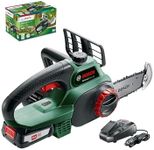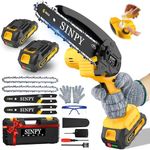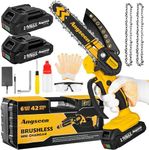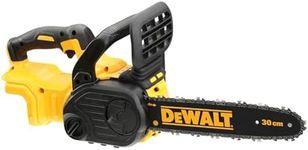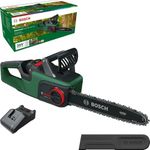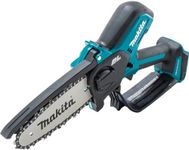Buying Guide for the Best Electric Chainsaw
Choosing the right electric chainsaw involves understanding your specific needs and matching them with the features and specifications of the chainsaw. Electric chainsaws are great for homeowners and light to medium-duty tasks. They are quieter, easier to maintain, and more environmentally friendly compared to gas-powered chainsaws. To make an informed decision, consider the following key specifications and how they align with your intended use.PowerPower in electric chainsaws is measured in amps. This spec indicates the strength of the motor and its ability to handle tough cutting tasks. Higher amp ratings (e.g., 14-18 amps) are suitable for more demanding jobs like cutting thick logs or hardwood, while lower amp ratings (e.g., 8-12 amps) are adequate for lighter tasks such as trimming branches or cutting small trees. Choose a power rating that matches the intensity and frequency of your cutting needs.
Bar LengthThe bar length refers to the length of the cutting bar and chain. It determines the size of the wood you can cut in a single pass. Bar lengths typically range from 10 to 18 inches for electric chainsaws. Shorter bars (10-14 inches) are ideal for pruning, trimming, and cutting small trees, while longer bars (16-18 inches) are better for felling larger trees and cutting thicker logs. Consider the types of tasks you'll be performing to select the appropriate bar length.
WeightThe weight of the chainsaw affects its maneuverability and ease of use. Lighter chainsaws (under 10 pounds) are easier to handle and control, making them suitable for extended use and for users who may not have a lot of upper body strength. Heavier chainsaws (over 10 pounds) may offer more power but can be tiring to use for long periods. Balance your need for power with your ability to comfortably handle the chainsaw.
Chain SpeedChain speed, measured in feet per second (fps), indicates how fast the chain moves around the bar. Higher chain speeds (e.g., 40-50 fps) allow for quicker and smoother cuts, especially in harder woods. Lower chain speeds (e.g., 30-40 fps) are sufficient for lighter tasks and softer woods. If you need to make fast, efficient cuts, opt for a higher chain speed, but for occasional or lighter use, a lower speed will suffice.
Safety FeaturesSafety features are crucial in chainsaws to prevent accidents and injuries. Look for features such as chain brakes, which stop the chain quickly in case of kickback, and low-kickback chains, which reduce the risk of sudden movements. Other important safety features include hand guards, automatic oilers, and tool-less chain tensioning. Prioritize chainsaws with comprehensive safety features to ensure safe operation, especially if you are a beginner.
Ease of MaintenanceElectric chainsaws generally require less maintenance than gas-powered models, but some features can make upkeep even easier. Look for chainsaws with automatic oilers to keep the chain lubricated, tool-less chain tensioning for quick adjustments, and easy access to the air filter and spark plug. These features can save you time and effort in maintaining your chainsaw, ensuring it remains in good working condition.
Corded vs. CordlessElectric chainsaws come in corded and cordless (battery-powered) models. Corded chainsaws offer continuous power and are generally lighter, but they require access to an electrical outlet and can be limited by the length of the extension cord. Cordless chainsaws provide greater mobility and are ideal for use in remote areas, but their runtime is limited by battery life. Choose a corded model if you have easy access to power and don't mind the cord, or a cordless model if you need more flexibility and portability.

